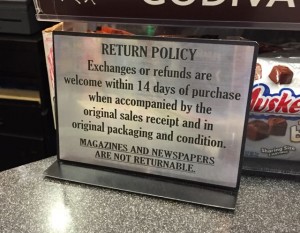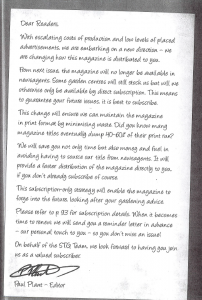If your retail business is in tough times and facing imminent closure, you may be able to save it if you act quickly and ruthlessly. Based on years of working with many different retailers, I have found that some basic steps can successfully turnaround a business in trouble. But you need to be ruthless.
The following tips are designed for businesses with a little (but not too much) time available to fix things. While they are not appropriate to every business, the ideas can lead to others that may be appropriate.
Crucial to saving a business from closure is to understand why it is in this situation. You have to be honest with yourself about this. How did it get to this?
- Did you not make changes to your business when you should have?
- Has something local and unexpected impacted your business?
- Have you been a bad retailer, allowing the business to fade away?
Do not be afraid or ignorant in confronting these questions.
Make an honest appraisal of the state of the business as the truth can inform what you do next.
You have to own your situation. This means being realistic about what you face and what got you there. This is important as it opens you to what you need to do to resolve the situation, to rehabilitate your business.
Now, to the urgent steps you could take to avoid the closure of your retail business:
- Know your truth. If you run a computer system, analyse the data it collects. If you don’t know how to do this, find out. Look for surprise information in your data, things you did not know about your business. For example, look at the top selling items. If there are surprises there they could inform other decisions you make to urgently address your situation. Talk to your computer software company, ask for their assessment. Knowing your truth is key to owning your situation.
- Quit dead stock. If you have stock on the shop floor which is old – ‘old’ can vary between product categories – and for which you have already paid, quit it. However, stock that is greater than six months old is a reasonable guide – then take action to sell this at a substantial discount. Move the stock off display units. Line it up to look like clearance stock – stacked up on tables. Setup plain and simple signs indicating the discount prices. Create signage to show it as clearance stock. If you have enough clearance stock in your business, consider signs across your front windows. Give your sale a name that is unrelated to your situation. Here are some suggestions: MEGA SALE, FIRST EVER MARCH SALE, AUTUMN SALE, SMALL BUSINESS MIGHTY BIG SALE. Give it a name you can theme around.
- Run a loyalty offer. Immediately setup and run a loyalty program rewarding shoppers with dollars off their next purchase. The most successful loyalty offer in recent times is discount vouchers whereby vouchers are included on receipts offering an amount which is cleverly calculated by your software based on the items in the purchase. The goal has to be encouraging shoppers to purchase again soon based on the offer on the receipt for items they just purchased.
- Move things around. If your business is in trouble it is likely that it has not changed much in recent years. Change it. Move departments around, shake things up so your customers trip over things they did not think you sold.
- Review prices. Look at the common items you sell, consider a small increase in your prices. It could be a small increase will not hurt sales volume yet will add profit to your bottom line.
- Upsell well. At the counter, work to extend the basket for every sale possible. Do this with clever counter product placement and witty and engaging banter with customers offering upsell products. You goal has to be to make more from each customer.
- Stand for something. What is different about your business? What is special about it? What makes people want to come back? If you don’t know the answer to these questions you’re in trouble. If your answer is we’re the only shop of your type nearby you’re in trouble. If the answer is people have always shopped here you’re in trouble. You need to have a difference that people want and will talk about to others. It could be a product or a service. However, it cannot be a product line that is traditional to your type of business as that will not add value to your shingle in the way you want or need. What do you stand for?
- Different retail options.
- Consider becoming an outlet shop selling items from a supplier keen to quit bulk items.
- Rent space in your shop to another retailer.
- If you have higher priced items consider offering employees commission on sales.
- Maybe become an outlet for local artists taking on items on a consignment basis.
- Stop unprofitable behaviour. If you are doing things in your business which lose money or do not contribute to a good future for the business, stop doing them. Regardless of history or what your business might stand for, continuing with unprofitable activity only makes your situation worse. If you know something to be unprofitable and yet you say you can’t stop it, think carefully about that, about why you can’t stop losing money.
- Get suppliers to help. Suppliers often have old stock themselves which they want to quit at a substantial discount. Buy items you have not stocked before, negotiate good prices and put the stock out with a healthy margin but still at a discount to what others would be charging. Negotiate to pay once you are paid by customers.
- Trim employee costs. Cut employee hours and work more in the business yourself if you are not doing so already. While this can have a significant personal cost, the less you pay others the more be business benefits in financial terms.
- Trim overheads. Cut everything you can: cleaning, power usage, insurance, freight, banking. Look at every supplier relationship you have and see if you can negotiate a better deal to cut your operating costs. However, do not turn off lights as darkness is death in most retail businesses.
- What assets can you sell? Do you have computers, retail fixtures, vehicles or other assets you no longer use in the running of the business? If they are not being used, turn them to cash as quickly as possible.
- Get a job. If you have a partner in the business with you and the business can run with one partner, one of you should get a job outside the business. This is especially helpful in a husband and wife situation where the family income can benefit.
- Talk to your landlord. A good landlord will prefer a good business to stay rather than have then close down and a new tenant having to be found. Talk to the landlord, be honest with them about your situation. Given the landlord all of the information they need to make the decision you need them to make. This information will include sales figures, expenses and margin information. Usually, the more transparent you are with the landlord the more they will support your business.
- Talk to your bank. While banks tend to not get involved in lending to businesses that are struggling, it may be that they have contacts that can help you navigate to a solution. Maybe talk to another bank.
- Talk to colleagues. If you have nearby business colleagues in the same line of business, they might have stock they are happy to provide you for free or at a discount to give you stock to move for a good price.
- Refresh the business. Make the business look, smell and sound fresh. Beyond the products you sell and where tings are located, change the environment itself using scents and sounds. Too often when a business is struggling, those involved let standards slip and the business does not look attractive to shoppers. Avoid this laziness at all costs.
- Deliver amazing customer service. When serving customers be the perfect shop assistance and not the owner of the business facing closure. Keep your mind on the job at hand and not the cliff you’re worried might be a few steps ahead.
- Whoever is pressuring you the most to close or contemplate closing, talk to them. If it’s a supplier, the tax office or some other organisation or individual pressuring you about debts, be upfront with them, lay out for them your plan detailing the action you will take to turn your situation around, be clear about what you are doing and outline a timeline step by step for them. Seek their support.
- Set a timeframe. Decide where you want to be in a week, four weeks, eight weeks, twelve weeks. Set realistic goals. Measure yourself against those goals. Know what you will do if you fall short.
What I am suggesting here is general advice. It is intended to get you thinking of ideas that could work for you.
No situation is impossible. No business is dead until the doors are closed for the last time.
Never give up. Fight hard and fight smart to turn your business around.
Facing tough circumstances in retail can be like the deer in the middle of the road facing an oncoming vehicle. Don’t freeze. Take action to mitigate your situation. A series of small steps could be the difference between closure and trading out of the problem.
I have prepared this in response to a comment from a colleague newsagent who asked for advice on how to deal with a business facing closure.
 I noticed Real Living in the sea of magazine colour in one newsagency and it stood out. In another shop they had it next to the bring Home Design and that title pulled focus from Real Living. In this situation I’d not place the titles next to each other so they are more noticed. However, I know others would try and colour block to make a bolder statement. Whatever you do, make thoughtful choices rather than plonking a magazine out without considering the cover and how you can best leverage this.
I noticed Real Living in the sea of magazine colour in one newsagency and it stood out. In another shop they had it next to the bring Home Design and that title pulled focus from Real Living. In this situation I’d not place the titles next to each other so they are more noticed. However, I know others would try and colour block to make a bolder statement. Whatever you do, make thoughtful choices rather than plonking a magazine out without considering the cover and how you can best leverage this.















